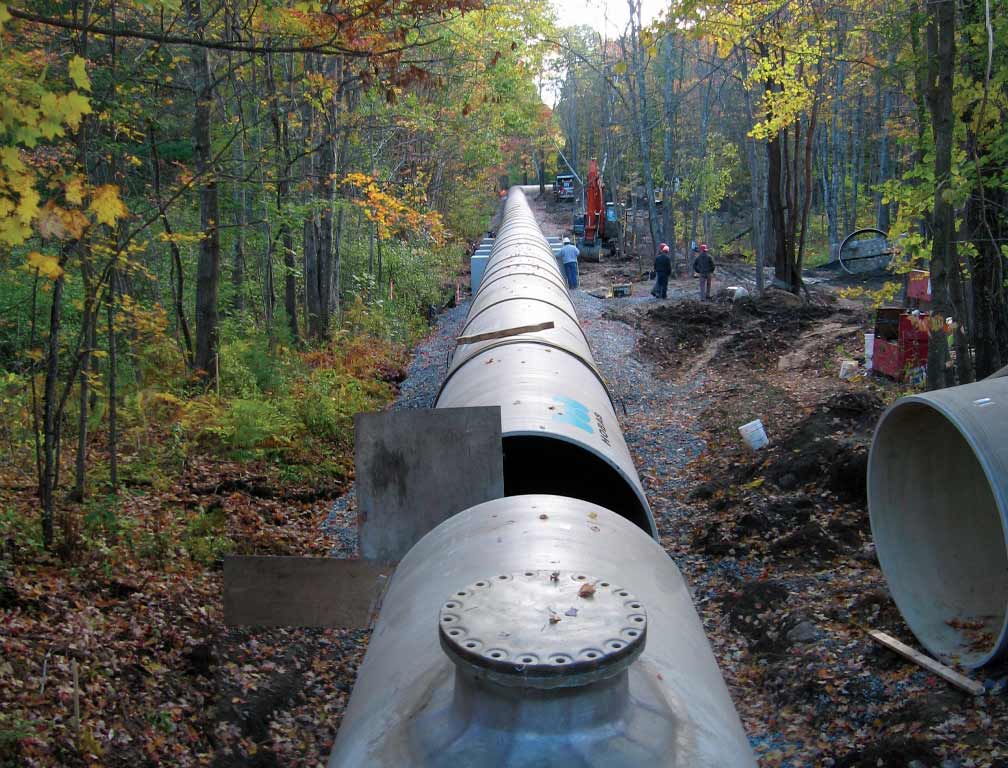
HOBAS Replaces Wood Stave Penstock in New Hampshire, US
Public Service of New Hampshire (PSNH), the Granite State‘s largest electric utility, serves more than 475,000 homes and businesses by means of nine hydroelectric plants. One of them is the Jackman Hydro Station in Hillsborough. Built in 1926, the station was supplied by a 1.52 km long wood stave penstock with a diameter of 2300 mm. After serious leakage problems and constant maintenance works, a significant rupture of the wooden pipe in 2003 lead PSNH to opt for a new pipeline.
Kleinschmidt, a company headquartered in Maine and specialized in energy and water resource projects, was employed to engineer a replacement pipeline. They evaluated five pipe material options: wood stave, concrete, HDPE plastic, steel and fiberglass reinforced polymer (GRP). The materials were compared regarding their structural reliability, corrosion resistance, hydraulic capacity, ease of installation (pipe weight) and performance history. The fiberglass option proved the most favorable. “The corrosion resistance and relative stiffness of GRP meant the pipes could be supported on the existing grade and half buried, rather than completely placed on saddles or covered in a buried trench,” stated Keith Martin, engineer with Kleinschmidt’s.
The pipe design flexibility, combined with a long projected service life made the client purchase CC-GRP pipes manufactured by HOBAS PIPE USA. The low frictional resistance of HOBAS CC-GRP Pipes allowed the replacement pipe to be reduced to a 2100 mm diameter.
The job site posed some challenges as it was a remote area and the installation point could not be accessed by truck. “More than 300 m of HOBAS Pipes were unloaded near the roadside. The individual pipe sections were then carried to the point of installation with an excavator,” said Newell Porter of the building contractor CCB. The first part of the installation was through a curve where 3 m joint sections were connected by a HOBAS FW Coupling and then deflected. After assembly, each single joint was successfully tested for tightness.
Most of the pipe was half buried in the shallow trench of the existing penstock, minimizing excavation costs and environmental disturbance. Approximately 91 m of the new penstock were supported above ground on steel saddles to minimize the impact to the wetlands that the penstock crossed. To achieve the higher axial strength necessary for the aboveground installation, additional reinforcement had been placed in the pipe during the centrifugal casting process.
The pipeline was put into service two weeks ahead of schedule and PSNH was more than satisfied. Once the line was in operation, the leak-tightness of the joints was checked once again and reconfirmed. Butch Lane from JML Trucking and Excavating, the installation sub-contractor for CCB, echoed the general contractor’s sentiments: “It really is a good pipe. We’ve had people come by and look at the project, and they are all happy.”
More information about this application
PROJECT DETAILS
| Project ID: [11077] | |
| Country: | United States of America |
| City: | New Hampshire |
| Year: | 2007 |
| Application: | Hydropower |
| Installation: | Above Ground |
| Technology: | Hobas |
| Total Length: | 311 m |
| Nominal Diameter DN: | 2100 mm |
| Nominal Pressure PN: | 4 bar |
| Nominal Stiffness SN: | 64000 N/m2 |
